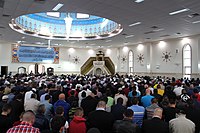Our website is made possible by displaying online advertisements to our visitors.
Please consider supporting us by disabling your ad blocker.
Afghan cameleers in Australia
| Part of a series on |
| Islam in Australia |
|---|
 |
| History |
|
| Mosques |
| Organisations |
| Islamic organisations in Australia |
| Groups |
| Events |
| National Mosque Open Day |
| People |
Afghan cameleers in Australia, also known as "Afghans" (Pashto: افغانان) or "Ghans" (Pashto: غانز), were camel drivers who worked in Outback Australia from the 1860s to the 1930s. Small groups of cameleers were shipped in and out of Australia at three-year intervals, to service the Australian inland pastoral industry by carting goods and transporting wool bales by camel trains. They were commonly referred to as "Afghans", even though the majority of them originated from the far western parts of British India, primarily the North-West Frontier Province and Balochistan (now Pakistan), which was inhabited by ethnic Pashtuns (historically known as Afghans) and Balochs. Nonetheless, many were from Afghanistan itself as well. In addition, there were also some with origins in Egypt and Turkey.[1] The majority of cameleers, including cameleers from British India, were Muslim, while a sizeable minority were Sikhs from the Punjab region. They set up camel-breeding stations and rest-house outposts, known as caravanserai, throughout inland Australia, creating a permanent link between the coastal cities and the remote cattle and sheep grazing stations until about the 1930s, when they were largely replaced by the automobile.[1] They provided vital support to exploration, communications and settlement in the arid interior of the country where the climate was too harsh for horses. They also played a major role in establishing Islam in Australia, building the country's first mosque at Marree in South Australia in 1861, the Central Adelaide Mosque (the first permanent mosque in Adelaide, still in use today), and several mosques in Western Australia.
Many of the cameleers and their families later returned to their homelands, but many remained and turned to other trades and ways of making a living. Today, many people can trace their ancestry back to the early cameleers, many of whom intermarried with local Aboriginal women and European women in outback Australia.
- ^ a b Afghan cameleers in Australia. 3rd September 2009. Australia.gov.au. Archived 5 August 2016 at the Wayback Machine. Accessed 8 May 2014.
Previous Page Next Page


